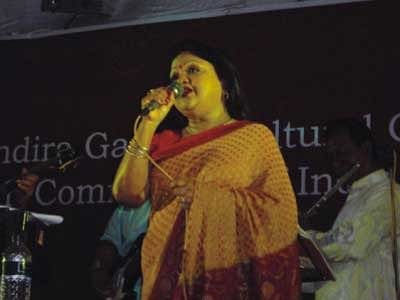Sabina Yasmin: Spring in the air

With Sabina Yasmin you go back to an era when songs came in melody. There used to be a time when songs came draped in music. It was an age when music was not another name for unbearable screams, when lyrics made sense. That is why you recall that simple number, ishara-e sheesh diye amake deko na / kamonar chokh diye amake dekho na. On a warm Friday evening, Sabina Yasmin was there at the Indira Gandhi Cultural Centre of the Indian High Commission in Dhanmondi making the crowds sway in rhythm with her.
There is that certain civility, a dash of dignity with which Sabina Yasmin has always offered her songs to us. On stage, she is a cool, graceful performer, taking care not to have the attention of the audience shift from her voice to her movements. Of course, the movements were there --- soft and steeped in quiet passion --- to let us in on the thought that music in the end is all about scaling the heights and taking the audience along.
And take the audience along with her is precisely what Sabina Yasmin did, from beginning to end on Friday. She began, as she always does, with a tribute to the country. This time it was shob kota janala khule dao na. Towards the end, it was jonmo amar dhonno holo maa go and ekti Bangladesh tumi jagroto jonota that left the breeze weaving itself into the crowd through tenderness which only the intensely patriotic among us can feel.
Observing Sabina Yasmin up close was in a way a coming to terms with reality once more. Not so long ago, we had almost given her up for lost, for reasons of her health. It was, for those of us who have watched her and her sisters create their own swathes of landscape in Bangladesh's music, a terrifying time given that Nilofer Yasmin had already gone missing for us. Sabina put up a brave struggle for survival; millions of hands went up in prayer for her. She came back home, to sing once more.
And there she was again, singing e ki shonar aloe jibon bhoriye dile. You were back in the 1970s, when Sabina Yasmin's was the dominant presence in playback music. The lights fell on her face, revealing beauty that only passionate adherence to music can have on offer. When the lights moved away, her beauty glowed in all its natural contours. That and the sheer romance of the song, aami rojonigondha phuler moto gondho chhorhiye jai, were a reminder to many of the essential spirit behind undying love.
The crowd, among whom were those who came to life much after the 1970s, cheered wildly. That was a beautiful surprise, a hint that for all the fusion and the fast beats you might go for in music in these more mundane times, it is always the connoisseurs of music who remember how it used to be all those decades ago. Sabina Yasmin, inundated with requests, let it be known that happiness was what mattered that evening. And hence the happy songs, one following another in swift succession. There was ei mon tomake dilam, succeeded by aami achhi thakbo bhalo beshe morbo.
You wished the evening would not draw to a close, but it did, had to. Within the circumscribed space of time, Sabina Yasmin at one point took it upon herself to regale the audience with Lata Mangeshkar's tum na jaane kis jahan mein kho gaye. Sabina Yasmin was simply making you fall in love again, in the autumn of your life. As the leaves dropped, ever so softly, from the trees made excitable by the winds, Sabina Yasmin led you, almost by the hand as it were, back to the 1960s, to Mehdi Hasan. She sang jaane mun aaj tu jo paas nehi jaane shireen mei wo mithaas nehi.
In your autumn, certain intimations of sudden spring punctuated the night sky.

 For all latest news, follow The Daily Star's Google News channel.
For all latest news, follow The Daily Star's Google News channel. 



Comments